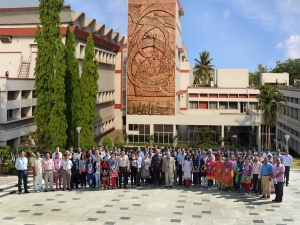

Situated on the island of Borneo in the Malaysian state of Sarawak, the Pan Borneo Highway is approximately 1,060 km long. As the very first project in Malaysia to integrate BIM and GIS workflows on a statewide highway plan, the project will widen the current two-lane single carriageway to a four-lane dual carriageway, connecting the cities of Sabah and Sarawak.
Some of the major sections of the Pan Borneo Highway include Bintagor-Julau section (28.5 km), Durin Bridge (1.9 km), and Sibu Interchange to Sungai Kua Bridge (46 km). A total of 18 bridges are a part of this project, including the Durin bridge over the Rajang river, the longest river in Malaysia. The project also includes two flyovers, seven pedestrian bridges, and 79 bus shelters.
To deliver the project, the Government of Malaysia and the Sarawak state government established a project delivery partner association called Lebuhraya Borneo Utara Sdn Bhd (LBU), as part of the Integrated Project Management System. LBU deployed Highway Information Model (HIM), an integration of Geographical Information Systems (GIS) for precise geospatial datasets and Building Information Modeling (BIM) for 3D parametric highway models. Further, LBU also used LiDAR data collected via drones in geo-referenced models to map the accurate location and height of the project site.
Federal Route 1, or the major trunk road system connecting the cities of Sarawak and Sabah with Brunei, is part of the Pan Borneo Highway and Asian Highway Network AH150. Of its total length of 1,060 km, only 13 percent (144 km) is a four-lane dual carriageway (JKR R5 standard), that is, the stretch from Sematan to Lawas. The rest of it is a two-lane single carriageway (JKR R3 standard). The two-lane single carriageway results in longer journeys for the commuters; travelling from Sematan to Miri can take up to 19 hours on the two-lane road. To solve the problem of traffic congestion and to boost socio-economic activities in Sarawak and Sabah, the Government of Malaysia in 2013 announced development plans for the Pan Borneo Highway. The toll-free four-lane dual carriageway project, however, was officially launched in 2015 and is scheduled to be completed in mid-2021.
Project Facts:
Stakeholders:
While assigning the project to LBU, the Government of Malaysia and the Sarawak state government mandated the use of BIM to use the Connected Data Environment (CDE) across the project lifecycle stages. In CDE, the design team was able to interact, collaborate and coordinate with stakeholders to resolve design issues, review the BIM models, the project deliverables, and contract management. Digital Twin (BIM+GIS+IoT) solutions enabled the project coordinators to contextualize the various objects surrounding the highway in one single model. The model and slope cut section were prepared through elevation models using GEOBIM (LiDAR + UAV + BIM). The progress timelines were monitored through WebGIS integrated with BIM, which enabled the stakeholders to view the project status in real-time.
LBU prepared the Digital Twin model by integrating the BIM and GIS models with non-spatial construction information. The Digital Twin model helped create GIS-based real-time dashboards of a road information system, maintenance management system, pavement management system, and bridge management system, which were all used to deliver the project efficiently.
Using BIM’s collaboration platform, the teams were able to work on the Cloud seamlessly and ended up saving substantial resource hours. Implementing the digital workflows saved the client and the project delivery partner MYR 160 million (USD 38.5 million) in Phase-I of the Pan Borneo Highway project.
The Pan Borneo Highway project is ‘future-ready’. To efficiently manage the large pool of data, the project delivery partner has initiated the expansion of big data and BIM applications for the operation and maintenance stage. There is already an asset management system in place, which includes information like asset inventory, maintenance, highway condition assessment, trend analysis of performance metrics, and data-driven decisions for capital planning.
Project Delay Information:
Tentatively, the completion date of the Sarawak portion of the Pan Borneo Highway project has been extended from June 2021 to June 2022, while the construction of the Sabah section has been extended from 2021 to 2023. This extension in the project timeline is due to multiple factors, namely, policy changes, retendering of various work packages, and termination of Syarikat Borneo Highway PDP and Syarikat Lebuhraya Borneo Utara (LBU) as project delivery partner (PDP) by the federal government. Previous Works Minister Baru Bian announced in February 2020 the termination of PDP model contract, which led to the transition of project responsibilities to Sarawak Public Works Department (JKR).

The European Union has been operating the world’s first system to limit and to trade carbon dioxide.
Unique digital map data will be shared across more than 500 Government departments and agencies and help deliver public services through more informed policy making, Planning Minister Sally Keeble announced.
© Geospatial Media and Communications. All Rights Reserved.